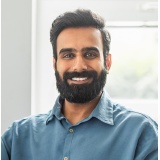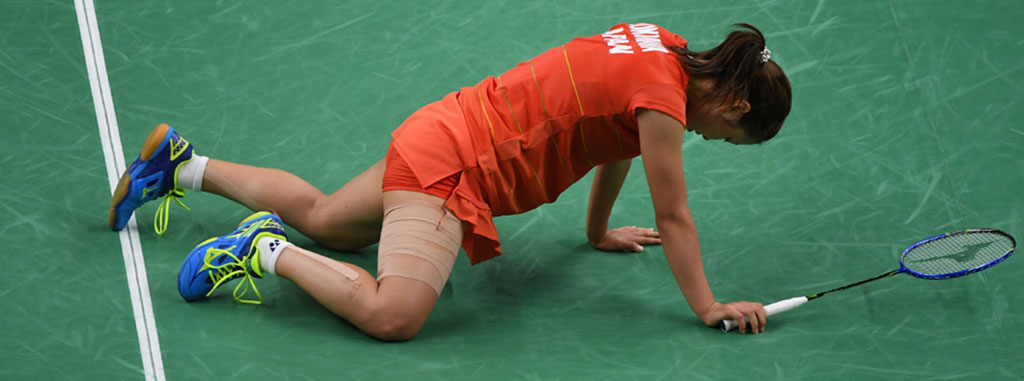
Badminton is a globally enjoyed sport. Playing badminton gives our bodies a rigorous workout and improves our hand-eye coordination.
But many people claim that badminton is a soft sport and does not cause injuries. Little do they realize the contrary happens when they end up having unexpected sports injuries.
In this article, we will learn about the common most badminton injuries.
Upper Body badminton Injuries
1. Tennis Elbow (Lateral epicondylitis)
Tennis elbow is one of the most common injuries in badminton. A tennis elbow is when your forearm (near the elbow) goes through excessive usage, causing many micro-breaks and inflammation near the lateral epicondyle or the bony edge of the elbow.
This condition leads to pain around the elbow area; according to a survey, around 1 in 10 people suffer from Tennis Elbow. However, this condition worsens over time and usually affects people between the ages of 40 and 50.
Symptoms
One can experience:
- Slight-severe pain around the outer side of the elbow
- Stiffness while expanding or stretching the arm
- Pain while lifting heavyweights
- Pain while gripping something tightly
- Pain when during flexion or bending of the arm
Treatment
Tennis elbow pain is a common injury in badminton that can be treated quickly. Professional treatment should begin with a complete analysis of the damage and history behind the amount of activity of the arm. Once the origin of the condition is clear, the following treatments can help recover quickly:
- Conventional treatments, like applying ice to the affected area consecutively, can help reduce pain over time.
- Good rest has always been a natural form of recovery for humans; good sleep encourages recovery faster.
- Massages are a good way to relax and heal all the inflamed muscles.
- Organic anti-inflammatory medication like CBD helps with swelling and pain.
- Physiotherapy that involves niche arm exercises helps the arm stay active and helps with stiffness.
- Wearing an elbow brace, strapping or support bandage or splint while playing can prevent further damage to the elbow
- Shockwave therapy has helped many people recover.
- Worst case scenario, you can go for surgery if the pain is unbearable.
- Avoid repetitive tasks: Change your workout regime to something that offsets your usual workout and relaxes your arm. Also, wear an elbow support.
- Stretch before and after you play: Perform certain arm and shoulder stretching exercises like arm flexion, wrist flexion, and other exercises that strengthen your forearm. Here are some badminton exercises for you.
- Take timely breaks: During practice or a game, if your arm is becoming sore, it needs rest.
- Check your technique: Many times, players do not follow techniques while playing, like too high tension in the racket means more vibration. They end up damaging their bodies forever. Get advice from a professional coach and learn how to play properly.
2. Shoulder Pain (Rotator Cuff Injury)
This is another upper-body badminton injury; the rotator cuff is a group of muscles and tendons that are around the shoulder joint.
This keeps the head of your upper arm bone firm in the shoulder socket. Shoulder pain occurs when your whole arm undergoes excess amounts of strain.
Shoulder pain or Shoulder injuries are very common injuries in the world. Many people who do not even play sports experience this quite often.
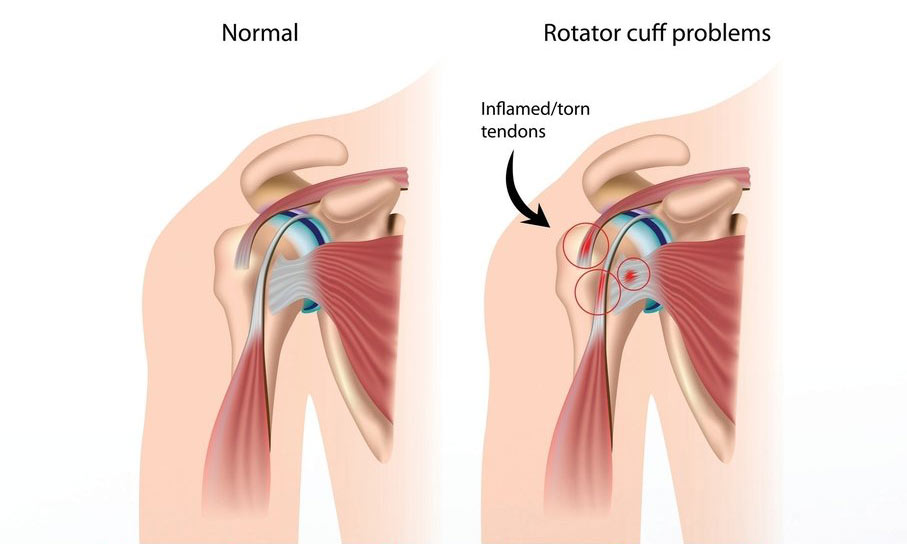
- Pain in the shoulder while lifting heavy objects
- Slight discomfort and pain while performing certain activities
- Neck pain while sleeping
- Tenderness in some parts of the shoulder and neck area
- In rare cases, you can feel the instability of the shoulder joint
- Wearing a shoulder brace can help reduce pain while doing general activities.
- Conventional treatment with ice, organic medication, and good rest
- Nitric oxide donor therapy: There is prominent evidence that patches of nitric oxides applied to the shoulder can increase recovery
- Corticosteroid injections at the subacromial region reduce pain and inflammation.
- Shoulder braces have been doing wonders to prevent further damage to the shoulder. You could wear a brace during training or even a match.
- Give your shoulder some break: Badminton requires a lot of work from the shoulder; wearing it out would only mean destroying your own body. Give your shoulder rest frequently.
- Adding salmon, cherries, pineapples, ginger, and turmeric helps sustain the joint integrity.
3. Wrist Pain
Wrist pain is a prevalent badminton injury. This is caused when the wrist experiences sudden forces, and a change in movement causes acute injuries.
At the same time, many people also experience hairline fractures and micro-breaks in the muscles in that area.
Wrist sprains can also be caused by the wrong positioning of the hand or gripping the badminton racket wrongly. Pain often develops gradually and, over time, becomes severe.

The wrist is a funny part of our body; the amount of pain or the flexibility of your wrist cannot really tell you what's wrong. It can either be broken or sprained. Certain symptoms are:
- Swelling around the wrist area and pain when you try to move it up or down
- Redness or discoloration in a specific area on the wrist and severe pain can be experienced when you touch
- Stiffness in the wrist while moving it
- Pain when you apply load or pressure on the wrist.
Treatment
- Anti-inflammatory medication can help reduce the wrist pain.
- Physical therapy that focuses on the wrist has been treating many players for generations.
- In some cases where you might get a fracture or rupture, going for surgery is the best option.
- Preventing wrist pain is not that difficult. You can start by building more bone structure. Taking adequate amounts of calcium can prevent wrist pain.
- Avoid falls and repetitive drills: Alright, falls are inevitable, but try to avoid landing on your wrists while playing. Repetitive drills can cause a lot of damage to the wrist, so make sure you are getting ample rest and breaks.
- Use medical wrist support while playing or training. Wearing before the pain starts is the best prevention you can take.
4. Blisters
Blisters are the most common form of badminton injury. They are generally observed on the palm, between fingers, or on the foot between toes.
The outer layer of the skin experiences friction burns and loosens up, filling the blister with lymph fluid.
These are not that dangerous but can cause infections and diseases if left exposed.
Blisters are a huge discomfort, but these can be prevented easily.
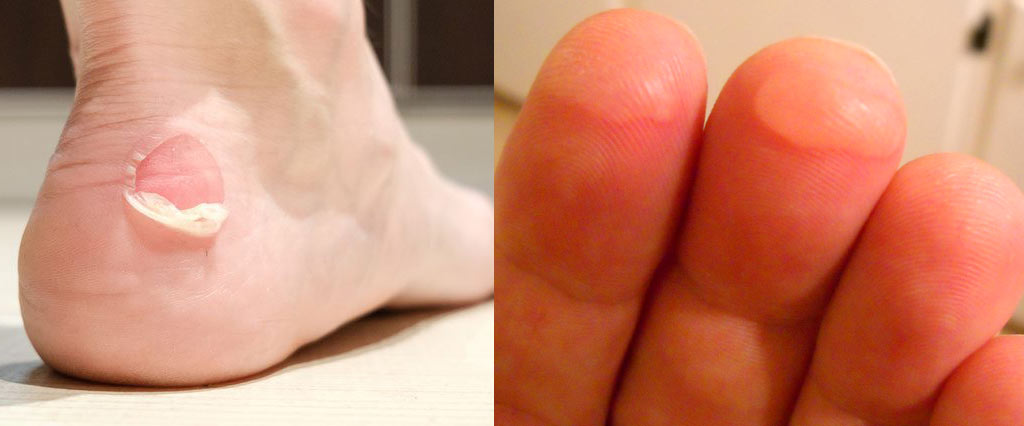
- You will notice a discolouration in the skin, maybe a slight redness on your palm, finger or sometimes in the foot as well.
- White, patchy, dried, and thick skin causes significant exposure of your inner skin when altered.
- Thick skin that hurts and dries very quickly
- Skin ointments that heal the skin are common treatments that can be cured by over-the-counter medication.
- Taping the affected area with medicated tape
- Immersing the affected area in warm water reduces blisters and heals dead skin.
- Make sure you change the badminton grip frequently.
- Tape sensitive areas on the hands to prevent further blisters
- If the blister forms on the foot, then get the required medication and change the type of badminton shoes you are wearing. Badminton shoes must have good mesh for ventilation. Without moisture, your feet will not rub against your socks or the inside of the shoes, thus helping prevent blisters.
- Try to keep your feet and hands dry most of the time; this prevents the skin from stretching and forming blisters.
Lower body injuries
Badminton is a high speed sport that requires agility and speed. Sudden changes in movement, random jumps, and untimely landings can cause a number of injuries to the lower body. Many foot injuries in badminton are ruptures and sprains caused on the heel and sesamoid bone.
5. Achilles Tendon Rupture
The Achilles tendon rupture is caused on the back of the lower leg. When the Achilles tendon is a strong fibrous cord that links the muscles to the back of your calf to the heel bone, overstretching the tendon can completely or partially tear the Achilles tendon. This is a very common phenomenon in many players throughout the world.
Sometimes, you can even feel the Achilles tendon injuries happening. You will notice a pop sound above your heel and a sudden striking pain in the back of your ankle and lower leg.
This leads to poor playing posture and problems in walking and running. There are plenty of treatments available for this common rupture.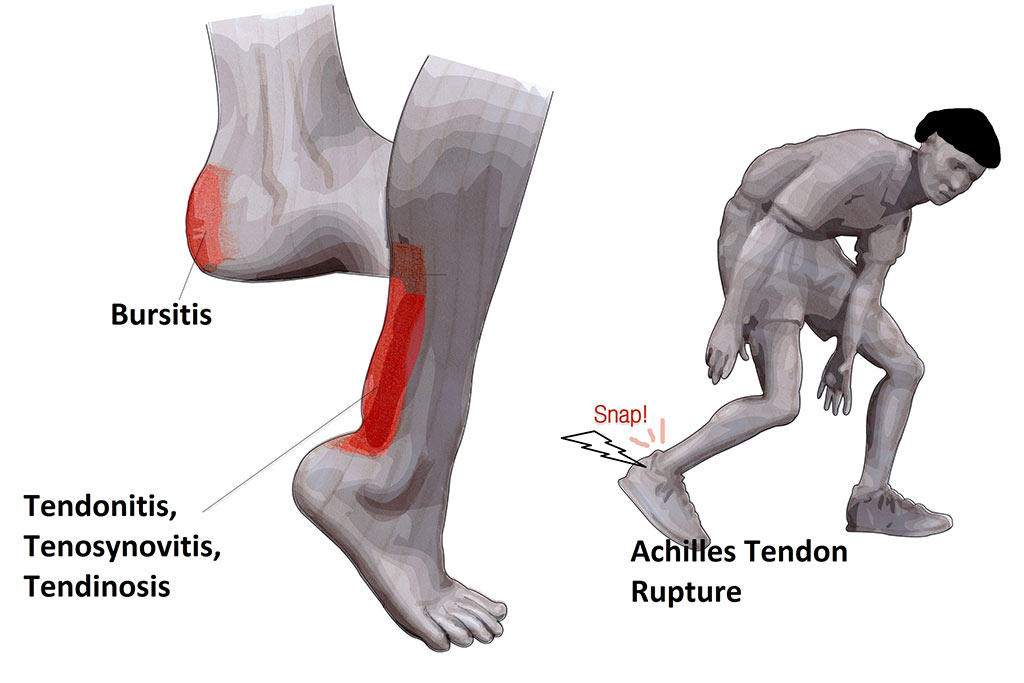
Sometimes, many people do not depict symptoms of Achilles tendon injuries. But many experience the following symptoms:
- A striking pain in the calf when walking
- Swelling and discolouration in and around the heel area
- People experience extreme pain in their calves when they try to stand on their toes
- A pop sound when the injury occurs.
- Conventional treatment with ice, organic medication and massages always helps.
- Surgery involves making incisions on the back of the lower leg and stitching over the torn tendon.
- Rest and rehabilitation physical therapy helps recover the torn tendon quickly.
- While training, always be careful of the surface you choose to run on; running intensely on an uneven, hard surface can lead to tendon ruptures.
- Vary your exercise regime: learn to change certain regimes that offset your lower body exercise.
- While training, do not go all out at once. Slowly increase the intensity of your training; this allows the tendon to adapt to the gradually changing intensities.
- If you have already had this condition before, it is advisable to go for a surgery option; this is because the surgery recovers the injury completely rather than gradual ups and downs of strain on your leg. Your leg is less likely to ever have a similar rupture in the future, provided you go for surgery.
6. Patellar Tendonitis (Jumper's Knee)
Patellar tendonitis is another common knee injury, which is popularly known as the jumper’s knee.
This is a painful condition in the proximal part of the patellar tendon, and the site of insertion into the distal pole of the patella is a painful condition involving the proximal part of the patellar tendon and the site of its insertion into the distal pole of the patella.
The patellar tendon is a cord-like tissue that connects the kneecap to the tibia or the large bone under your knee to the foot.
Repeated micro-fractures and sustained overload cause patellar tendonitis on a ligament due to constant training that involves jumping, landing, and other cardio-based exercises.
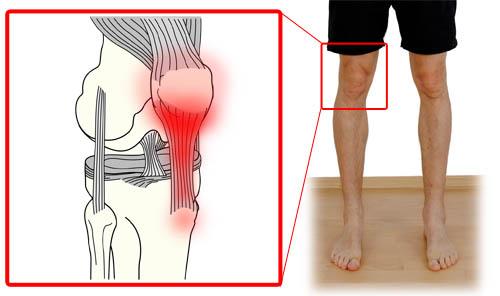
You may experience:
- Sudden pain when you change the direction of your foot while doing an activity
- Stiffness in the knee and discomforting pain while jumping, running or bending
- Pain on the quadriceps muscles
- Discoloration to dark or bluish skin
- If the pain is mild and does not affect your game too much, then follow the conventional method of applying ice, heating pads, organic medication, wearing a knee guard and massages.
- A Neoprene knee support with a patella tendon strap applies ample pressure to the patellar tendon. This can help distribute force away from the tendon and direct it through the strap instead. This helps relieve pain and recover fast.
- Iontophoresis is a therapy where corticosteroid medication is spread on the skin, and low levels of electrical charges are applied to the skin that pushes the medication inside.
- The oscillating needle procedure is a helpful but unconventional method of treatment. Here, local anaesthesia is applied with the help of small oscillating needles that cut the damaged area while giving room for a healthier tendon.
Prevention
- Do not play through the pain. This can cause the tendon to damage further, leading to permanent damage over time.
- Strengthen your muscles with proteins and supplements that keep the tendon strong.
- Always be careful while landing or changing movements; make sure you use the right physics behind your movements on the court.
7. Sprained Ankle
Ankle sprains are no new phenomenon; many people who aren’t sportsmen/women experience them on a regular basis.
In a sprained ankle, the ligament that surrounds and connects the bones of the leg to the foot bone is a popular badminton injury.
Many times, players twist their ankles on landings and change directions, which leads to fractures and muscle tears.
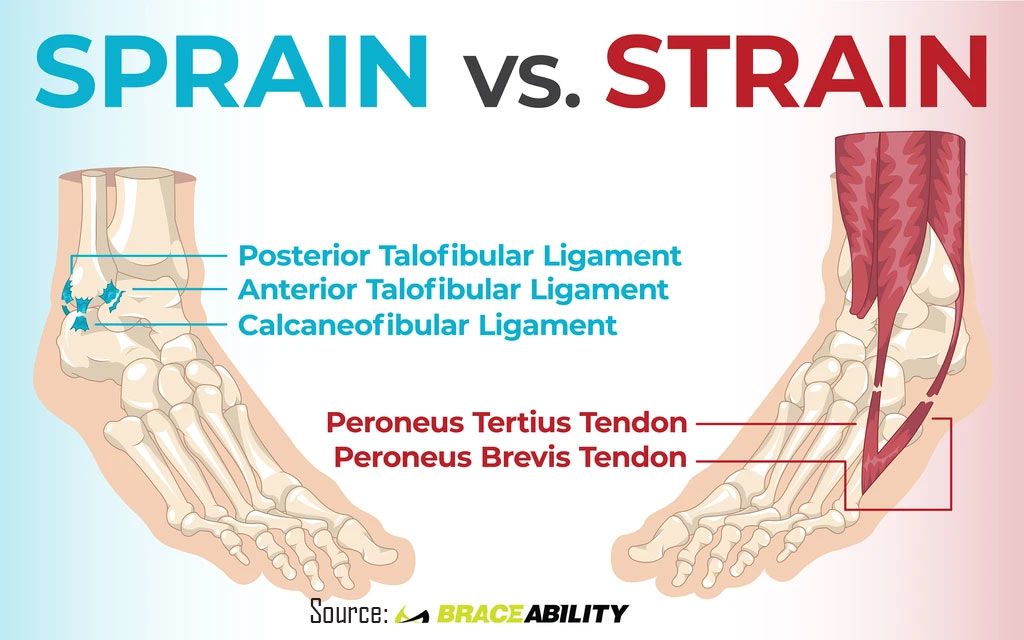
You may experience:
- Swelling around the ankle
- Redness or discoloration above the heel and around the ankle
- Stiffness in the ankle
- Tenderness in specific places of the ankle when pressure is applied to them
- Convention rest, ice, and medication can help recovery speed up.
- Casts or ankle braces support the plantar fascia and Achilles tendon in a straight position. Using them overnight can help recovery drastically.
- Physical therapy that involves ankle joint exercises helps to a great extent in recovery.
- Always warm up before you go for a training session or a match.
- Research on good badminton shoes that reduce impact when you land after a jump. Go for shoes that are light with good cushioning, but keep your ankle placed correctly always.
- Wrap ankle tape or wear ankle support before any exercise that involves the ankles.
Conclusion
Badminton is indeed a fun sport that requires a lot of skill and endurance. However, the average recovery time for most common badminton injuries is 48 days, which is still higher than that of many other sports injuries.
Allowing the body to recover fully is a big factor that not only prevents future acute badminton injuries but also depicts a level of self-discipline and patience.
FAQ: Common Badminton Injuries
Q1. What are the most common injuries in badminton?
Badminton players commonly experience injuries like tennis elbow, ankle sprains, shoulder injuries, and knee injuries.
Q2. How can I prevent tennis elbow while playing badminton?
To prevent tennis elbow, ensure proper technique, use the right equipment, warm up before playing, and strengthen forearm muscles.
Q3. How can one play the game without risking an ankle sprain?
To prevent ankle sprains, wear proper footwear with good ankle support, perform ankle strengthening exercises, and be cautious of sudden movements.
Q4. How can I reduce the risk of shoulder strains in badminton?
To lower the risk of shoulder strains, maintain proper form while swinging, stretch before playing, and strengthen shoulder muscles.
Q5. What are some exercises to strengthen knees for badminton?
Squats, lunges, leg lifts, calf raises, and hamstring curls are a few exercises that reduce the chances of knee injuries.
Q6. What should I do if I get injured during a badminton game?
If injured, stop playing badminton immediately, rest, apply ice to reduce swelling, compress the injured area, and elevate it. Seek medical advice if required.
Q7. Can I still play badminton with an injury?
Your ability to play badminton with adjustments or limitations will depend on the kind and extent of your injury. For risk-free recommendations to get back into sports, it's best to contact a doctor.
Q8. Can I continue playing badminton while recovering from an injury?
It's essential to consult a healthcare professional. Some injuries might allow modified play or specific exercises, while others might require complete rest.
Q9. What measures can I take to minimize the risk of recurring injuries?
Follow a proper warm-up routine, use appropriate gear, maintain good technique, gradually increase the intensity, and listen to your body to prevent re-injury.
Q10. When should I seek professional medical help for badminton injuries?
Seek medical attention immediately for an accurate diagnosis and effective treatment if the injury is causing substantial swelling, instability, discomfort, or limited mobility.
Your email address cannot be published. Required fields are marked*

 My Account
My Account Track Order
Track Order Sports Guide
Sports Guide